
[Back]
|

[Index]
|

[Next]
|
FM 34-37
Strategic, Departmental, and Operational IEW Operations
Preliminary Draft
|
Chapter 4
FORCE PROJECTION BRIGADES (FPB)
1. Introduction
U. S. national military strategy articulates a military force power projection doctrine to protect U. S. strategic interests around the world. Current strategy identifies the requirement for
the military to be prepared to respond to Major Regional Crises (MRCs) in Korea and the Persian Gulf (i. e., MRC- West and MRC- East, respectively). The military functionality executing the
power projection concept is force projection; modular, deployable forces, tailored in nature in order to meet the full range of global missions and requirements. The operational outgrowth of
this concept is the tailored force package.
In meeting the full range of global operations with scarce resources and capabilities,intelligence assets are tailorable and modular. Modularity is a force design methodology
establishing a means of providing force elements that are interchangeable, expandable and tailorable in meeting changing needs. Modularity permits detaching functions and capabilities
from a parent unit and tailoring such functions and capabilities within a force projection force.The parent unit remains operative and retains the capability to perform all its mission functions.
Echelon above Corps intelligence units conduct force projection operations from CONUS-
based and theater- deployed assets. This chapter describes the force projection brigades (FPBs)mission, structure, roles and functions. It discusses the resources available and how they provide
intelligence, electronic warfare (EW), force protection and deception support to CINCs, JTFs and tactical commanders. It also discusses functional and coordination requirements, insight into the
duties of the key players, and how they interface.
The FPB concept, aligned with the MRC concept, divides the world into two regions: East and West. Each region is supported by EAC intelligence assets concentrating on the MRC
with resources available to support stability and support operations (SASO). The regional assets consist of the Theater MI Brigades.
The 513th MI BDE forms the CONUS- based nucleus of the Force Projection Brigade-
East. The 66th MI GP, while authorized on the Force Projection Brigade document, is an independent forward- deployed Theater unit in support of USAREUR. Additionally, with the
deactivation of the 470 th MI Bde, the 513 th MI maintains an element in Panama. This change reflects transitions occurring in the European and Central American theaters.
The FPB- West support concept is, as such, not in place for MRC- West, but the
functionality is executed differently. A Theater MI Bde remains as the supporting MI element for Eighth U. S. Army (EUSA), and remains in Korea until reunification of Korea or the withdrawal
of EUSA. A second Theater MI Bde remains as the USARPAC MI supporting element with headquarters in Japan and supporting elements in Hawaii. The reserve components (RC)
designated to support EAC are wartraced to specific theaters and are mobilized as cellular teams.RC support to FPBs is discussed in greater detail later in the chapter.
2. Mission
"Force projection brigades conduct theater level multi- discipline intelligence, force
protection, counter- drug, electronic warfare, and information warfare operations in
support of army component commanders, land force component commanders and other
deploying forces in providing timely critical intelligence support to the warfighter during
peace time, war, and support and stabilization operations."
3. Organization
The organization of the objective force projection brigade is depicted in figure 4- 1.
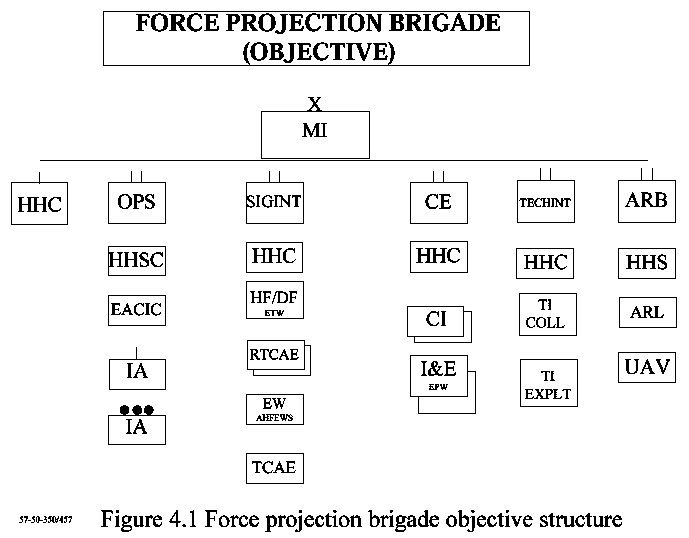
3.1 FPB Command and Control (C2)
FPB commanders use C2 to direct and coordinate military forces to accomplish their
missions. This process encompasses the personnel, equipment, communications, facilities, and procedures to gather and analyze information; to plan for requirements; to issue instructions; and
to supervise the execution of operations. Communications allows commanders to direct operations on the battlefield and to monitor their execution. It is a critical element of battlefield
synchronization.
FPB IEW structure supports the C2 process. The intelligence assets organic to or leveraged by the FPB enable the commander to see, shape, shield, strike and move within the
battlespace. Intelligence feeds the concept development and planning of the staff which results in
the command estimate. Once developed, the command estimate is continuously evaluated for changes required because of shifts in the situation. Intelligence processes, such as IPB and CM,
shift accordingly to answer the commander's intelligence requirements and to help maintain the currency and validity of the estimate.
3.2 FPB Intelligence and Electronic Warfare Command and Control
Specific C2 arrangements between the FPB and supported commanders are addressed in
OPLANs and concept plans. These plans are formulated during the deliberate planning process.The FPB C2 system provides long- range planning, centralized management, and decentralized
execution. Figure 4-2 show C2 supporting relationships.
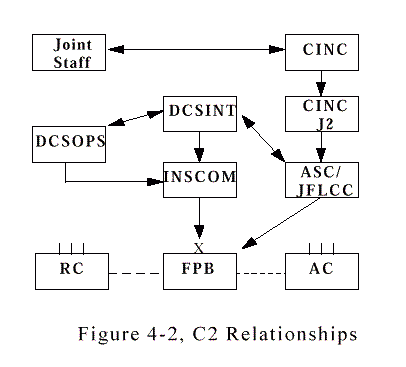 IEW C2 is the responsibility of the commander. It is supported by the commander's staff,subordinate commanders, and the relationships with higher echelons of command, the host nation,
Allied services commands, and the supported US forces. (For details on commander and staff roles, see FM 101- 5.) to accomplish the C2 mission, the FPB MI brigade commander ensures--
IEW C2 is the responsibility of the commander. It is supported by the commander's staff,subordinate commanders, and the relationships with higher echelons of command, the host nation,
Allied services commands, and the supported US forces. (For details on commander and staff roles, see FM 101- 5.) to accomplish the C2 mission, the FPB MI brigade commander ensures--
Effective mission accomplishment with the resources on- hand.
C2 functional responsibilities are clearly defined.
Clear command and reporting channels are established (for example, between the
EACIC and supported commands).
Assignment of IEW missions and tasks is consistent with the unique capabilities of the units to which IEW assets are assigned.
Continuous coordination is maintained among staff elements of all MI units and the
FPB.
Information management and communications systems are integrated s
that the commander's PIR and IR are acted upon quickly.
Detailed plans are made for an orderly transition from peacetime to wartime or
contingency operations.
The FPB supports the C2 for IEW operations by--
Providing a C2 headquarters for Army IEW support to theater commanders. These commanders may include Allied Army groups with OPCON of US Army forces, Allied regional
commands, a unified and specified command, and separate US Army units. There may also be a JTF command during contingency operations.
Conducting IEW operations in support of all operations.
Managing IEW resources required for collecting, analyzing, producing, and
disseminating all- source intelligence and CI within the theater.
3.3 FP Brigade Core Competencies
Core competencies are talents, capabilities and systems unique to the force projection brigade. The core competencies of the force projection brigade provides distinct competitive
advantages over any potential adversary and include:
All- source collection management, analysis, tailored production and dissemination to support the land component commander (LCC).
Ground and aerial SIGINT collection and aerial MTI collection.
Intelligence support to information operations (C2 protect and ground- based electronic
warfare support to C2 attack).
Counterintelligence support to force protection and interrogation.
Reach- back/ Theater linkage to strategic/ national intelligence assets.
Battlefield technical intelligence
3.4 FP Brigade Roles and Functions
Roles and Functions
The FPB perform multi- discipline intelligence, force protection, counter- drug, EW and IO
operations to support the ACC/ JFLC commander's requirements. Specific functions include:
Provide intelligence in support of force projection. The force projection brigades
support JFLCC with dedicated intelligence, information, and communications systems, by surging
special purpose and reserve components, by employing all intelligence disciplines, and by
leveraging national intelligence assets.
Provide intelligence and counterintelligence in support of information
warfare/ information operations (IW/ IO). Army IO supports Army operations through protection
of the commander's battlefield decision cycle while preventing the adversary to effectively operate
within his own decision cycle. In support of IO, C2W databases are developed. The Army
develops its ability to provide intelligence in support of the three subcomponents of IO: C2
Attack, C2 Exploit, and C2 Protect.
Conduct intelligence collection and production. Included in this requirement is the need
to provide long- term collection, analysis, and production in support of land component elements
of the supported CINC. All intelligence disciplines and associated sensors are included.
Conduct intelligence operations in support of force protection. In support of force
protection, the FP brigade leverages its resources associated with counterintelligence resident in
the collection and exploitation battalion to include host nation liaison teams, strategic debriefing,
and polygraph to support the JFLCC J- 2.
The objective of intelligence in direct support of the warfighter is to collect, analyze,
produce, and disseminate combat information and intelligence to assist the direction and
synchronization of maneuver and support forces. The intelligence functions include the capability
to conduct indications and warnings (I& W), intelligence preparation of the battlespace (IPB),
situation development, targeting, force protection, and battle damage assessment (BDA). These
functions are briefly described in the following paragraphs.
Indications and warnings (I& W). I& W involves the continuous development and
refinement of threat activities and possible intentions. This allows joint operational intelligence
staffs to determine changes in the political, military, economic, and diplomatic behavior of an
adversary using all- source intelligence to avoid surprise.
Intelligence preparation of the battlespace (IPB). IPB is the systematic, continuous
process for developing databases for each potential operating area. Data is analyzed to determine
the potential impact of the enemy, weather, and terrain on both enemy and friendly operations;
and presents the results, usually in graphic form. IPB supports situation development, targeting,
force protection, and BDA.
Situation Development. Situation development is the continuous process providing the
commander an estimate of the situation and threat intentions. Products include order of battle
(OB) updates; threat intentions and probable courses of action (COA); dynamic, graphic
intelligence summaries with predictive assessments; decision- support, doctrinal, event, and
situation templates; and weather, light, and terrain decision aids.
Targeting and Target Development. Targeting is the process providing timely and
accurate targeting data to support effective attack by fire, maneuver, or electronic means. The
targeting process is able to direct and redirect organic and supporting collection assets as well as
detect, locate, identify, and report threat maneuver, fire support, combat service support, C3
elements, and high payoff/ high value targets (HPTs/ HVTs) such as nuclear and chemical weapons
systems within the area of interest
Force Protection. Force protection includes all active and passive measures designed
to provide security to the friendly force. This includes all operational security (OPSEC) support,
counter- SIGINT (C- SIGINT); counter- reconnaissance, intelligence, surveillance, and target
acquisition (C- RISTA); deception support; and reconnaissance and surveillance measures taken to
identify and counteract threats to the friendly force's physical and operational security.
Battle Damage Assessment (BDA). BDA is the process of assessing the physical
damage done to personnel and equipment in support of order of battle analyses and predictive
estimates of future threat capabilities, activities, and intentions. This includes an analysis of the
threat's ability to direct, support, and sustain his force.
3.5 Major Subordinate Units
The following sections describe the mission, organization, roles and functions of the major
subordinate units of a force projection brigade.
3.5.1 Operations Battalion
This section describes the mission and structure of the a generic MI battalion(Operations), its analysis and control element (ACE) and other subordinate units. Figure 4- 4
shows the organization of a typical MI battalion (Operations).
Mission
"Provide all- source intelligence, targeting, collection, communications and force projection support to ASCC/ JFLCC, CINCs, joint or combined forces."
Organization
No two MI battalion (Operations) are organized the same. This is due in part to specific
Theater requirements, geographic focus and availability of assets. All however, share to varying degrees, some commonalties. Typical MI battalions (Operations) consist of a headquarters and
headquarters service company (HHSC), an EACIC company, an imagery analysis company, and a strategic imagery analysis detachment. These organizations contribute to the efficient operations
of the IEW structure for the ASCC/ JFLC commander and provide specific intelligence collection capabilities to support the information needs of the Theater in which they are located. The
battalion can also accept the attachment of tactical reconnaissance support detachments and other functional area cellular teams when mobilized from the RC.
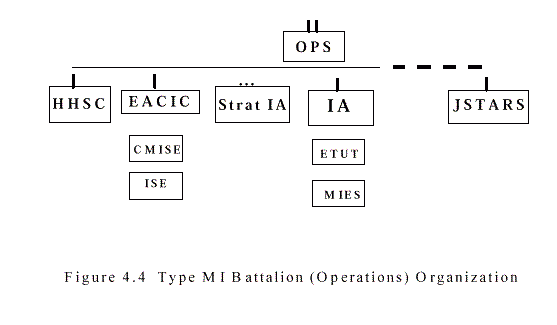
Roles and Functions
The following are typical roles and functions of the MI Battalion (Operations):
Integrate all- source intelligence analysis, production, and dissemination.
Provide intelligence support for assessing battle damage.
Provide intelligence, analysis, and support to OPSEC.
Provide intelligence analytical support to battlefield deception.
Provide near- real time exploitation, reporting, and rapid dissemination support of FPB
and/ or national level collected imagery.
Provide CM, data base management, tasking guidance, and tasking for sensor cueing in support of FPB.
Provide imagery analysis from national imagery systems.
Provide mechanical and communications maintenance and administrative support for the
battalion, attached units, and the HHD of the ASCC brigades as required.
Provide intelligence and analysis support to wartime reserve mode (WARM) and reprogramming operations.
Maintain signature data base reference files that are used to identify automated/ smart
sensors, processors, and smart munitions and weapons affected by a WARM or altered signature.
3.5.1.1 Echelons Above Corps Intelligence Center (EACIC)
Mission
"The EACIC plans, directs, and coordinates IEW operations. The EACIC provides timely,relevant, accurate and predictive intelligence needed to answer the Commander's
requirements."
Organization
The EACIC consolidates the FPB's assets for all- source production and collection management. A typical EACIC is shown as Figure 4- 5. The collection management section
(CM) is responsible for requirements and mission management. The CM section develops the collection plan and uses the intelligence synchronization matrix (ISM) to ensure collection is in
concert with the commander's intent and the operation. The production section (PROD) is the culmination point where data enters and is analyzed and correlated to produce all source
products. The production section contains the all source production and dissemination team,order of battle team, and the targeting / BDA team. The production section also consolidates
single discipline reporting. Current and forecasted weather and terrain support is provided by the integrated meteorological section (IMETS). The EACIC also contains the Corps MI support
element (CMISE) and intelligence support elements.( ISE). These elements are tailored to needs of the supported unit. They perform liaison duties, ensure continuity and leverage Theater and
National assets as necessary. Refer to FM 34- 25- 3, EACIC/ ACE/ ASAS Operations for detailed information.

Roles and Functions
The EACIC performs the following general functions:
I& W.
All- source intelligence production
Situation development.
Target development.
EW.
Security and deception.
Counter WARM and support reprogramming operations.
Collection management
Intelligence and information dissemination.
BDA.
IPB.
Each theater EACIC is geographically oriented. Its IEW support is diverse for both
peacetime and wartime. The EACIC may be tasked with different intelligence requirements ranging from strategic to regional areas of a joint command with assigned AOs or AIs. In some
theaters the EACIC supports combined commands. Each command shares wartime requirements of identifying enemy activity within its area of operations (AO) and of supplying intelligence to
commanders charged with the conduct of rear operations.
The intelligence staff is an integral part of the commander's campaign planning process andes constantly attuned to changes. Throughout the conduct of the above support operations, the
EACIC remains focused on the operational intelligence requirements of the conflict. These include:
Enemy centers of gravity as the commander directs the campaign plan (or phases) to
expose and attack it.
An attacker's culminating point, to enable the friendly commander to seize the initiative for offensive operations.
The EACIC is organic to and under the administrative control of the MI Battalion
(Operations). However, the EACIC is under the operational control (OPCON) of the G2/ J2. TheG2/ J2 is the Senior Intelligence Officer (SIO) in Theater and, as such, is directly responsible for
all intelligence activities of the command. The EACIC is normally collocated with the supported G2/ J2. The EACIC coordinates with national level intelligence agencies, sister services, allied
forces, adjacent and subordinate units to satisfy the intelligence requirements of the commander. Figure 4-6 shows EACIC relationships.
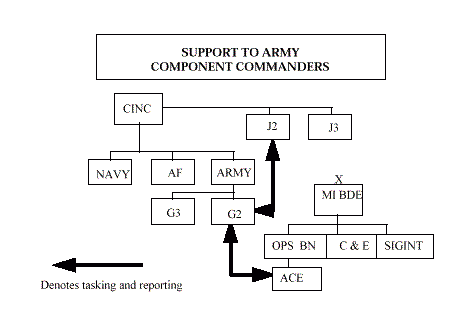
Collection Management Section
The CM section is responsible for requirements and mission management. Requirements management defines what to collect. Mission management defines how to satisfy the requirement.
The CM primary function is to use all collection resources available to assist the G2/ J2 in satisfying the commander's intelligence requirements.
The process of formulating detailed collection requirements begins with the receipt of
intelligence requirements and requests for information (RFIs). The collection manager first ensures that the information needed to satisfy the requirement does not exist. The collection
manager then begins the process of selecting the most appropriate collection assets. The collection manager must have a thorough knowledge of collection systems and understand their
operational employment limitations in order to determine which sensor or intelligence discipline should be used to satisfy a requirement. This is a priority for successful mission management.
The collection manager is assisted in this process by the single source teams (SST) of the production section.
The CM section tasks the FPB for collection missions. It requests information and
receives taskings from national intelligence systems. As the coordinator of the brigade's collection efforts, this section formats collection requirements which are satisfied by organic assets and forwards them to the appropriate SST for action. The collection manager, working with the SSTs, translates requirements into observables or information indicators from which specific intelligence requirements are developed. Refer to FM 34- 2, Collection Management for detailed
information. Specific functions of the CM section include:
Directs and synchronizes the collection effort.
Provides CM assistance to corps and below intelligence units to ensure intelligence shortfalls do not exist.
Interfaces with production section analysts to respond to consumer requirements.
Coordinates joint requirements.
Leverages national systems
Monitors dissemination of intelligence products in response to RFIs and taskings.
Manage IMINT, MASINT, SIGINT, HUMINT, and TECHINT collection
requirements.
Production Section
ASPD & OB Teams
The all source production and dissemination team (ASPD) in concert with the Order of Battle (OB) Team, determines if intelligence requirements and RFIs can be satisfied with its
existing information and data base holdings. Information not available defines the collection requirements. The collection manager then tasks collection assets within theater or requests
support from national level assets. These two teams determine what enemy information is available to help identify specific indicators of enemy intent and provide a current, integrated
picture of the battlespace. During the analysis and production portion of the intelligence cycle, the ASPD and OB teams coordinate with and receive information from the other production
section teams. This constant exchange of information ensures single discipline reporting is fused into all- source products. Refer to FM 34- 3, Intelligence Analysis for detailed information.
Specific functions of the ASPD and the OB Teams include:
Maintain Theater Ground and Electronic Databases
Prepares and disseminates Intelligence Preparation of the Battlespace (IPB) and other all source products
Tracks enemy capabilities and intentions
Performs predictive analysis and threat assessments
BDA & TGT Team
BDA and targeting team (TGT) performs target development selection and assessment.
Based on collected all source intelligence, the team identifies target vulnerabilities, provides targeting data and nominates targets in accordance with the commander's HPT lists and the attack
guidance matrix (AGM). The BDA/ TGT will also assess battle damage based on physical damage sustained by the target and their remaining combat effectiveness. Refer to FM 34-1,
Intelligence and Electronic Warfare Operations for detailed information.
CI Team
The Counterintelligence Team performs CI analysis. The team assesses the adversary's intelligence collection capabilities and operations directed against friendly forces, missions, and
installations. The adversary uses many methods to collect information against friendly forces,including HUMINT, SIGINT, and IMINT. As a result, the CI analytical capability includes a
diverse mix of specialists who fuse information to identify and isolate collection operations. The CI team and other elements of the production section exchange critical information required to
analyze the enemy. Intelligence gaps and lack of holdings are provided to the CM section for action as appropriate. Refer to FM 34-60 Counterintelligence for detailed information. Specific
functions of the CI team include:
Develops and maintains CI data bases.
Monitors CI collection efforts.
Produces IPB products to support CI operations.
Produces analytical products, including threat assessments, estimates and summaries,threat situation overlays, and black, white, and gray lists.
Single Source Teams.
The SSTs facilitate single source reporting and requirements coordination from tactical,
theater and national sources. Further, SSTs provide expertise and advice concerning single discipline employment, sensor operating parameters and capabilities.
MASINT Team
The measurement and signature team analyzes data obtained from technical means such as
radars, lasers, magnetic and seismic sensors in establishing and updating target signatures. The MASINT team provides technical advice and expertise on understanding MASINT capabilities,
employment of MASINT collection devices, and potential countermeasures to negate an adversary's technological advantage. The MASINT team coordinates with and leverages
information from national MASINT agencies. Specific functions of the MASINT team include:
Receive and processes collected information and forwards it to the all- source production team for all- source analysis.
Provide technical advice and assistance through the use of MASINT- exploited target
signatures or MASINT collection devices.
Coordinate with elements of the CONUS support base, industrial and scientific communities, and other services to ensure that new technology is integrated into operations.
SIGINT Team
The signals intelligence team coordinates SIGINT tasking requirements, provides advice
on the employment and capabilities of noncommunictions/ communications intercept and processing assets and integrates SIGINT data into all source products. The SIGINT team
provides a direct link to the Theater technical control and analysis element (TCAE) supporting SIGINT tasking and collection activities and collection management authority functions. Refer to
FM 34- 40, Electronic Warfare Operations for detailed information. Specific functions of the SIGINT team include:
Primary interface with the Theater TCAE.
Analyzes collection requirements received from the CM section, based on resources
available and parameters of coverage.
Advises the CM section of suitability for satisfaction of collection tasks.
Monitors the status of tasks levied to the SIGINT battalion and makes recommendation st
the theater TCAE regarding employing resources.
In conjunction with the TCAE, coordinates sensor cueing to support other IEW
requirements.
HUMINT Team
The human intelligence team coordinates employment of and support to theater interrogation assets. Refer to FM 34- 52, Intelligence Interrogation for detailed information.
Specific functions of the HUMINT team include:
Develops and coordinates theater interrogation operations and controlled collection requirements.
Performs cueing and tip- off for theater and national assets.
Translates tasking received from the CM section into specific collection tasks.
Provides combat situation updates to theater interrogation assets.
IMINT Team
The imagery team coordinates imagery analysis requirements and activities for the EACIC.
IMINT team supports intelligence tasking requirements, performs 3rd Phase exploitation;prepares imagery analysis reports and leverages support from the Strategic Imagery Analysis
Company of the MI Battalion (Operations). Refer to FM 34- 55, Imagery Intelligence for detailed information. Specific functions of the IMINT team include:
Coordinate imagery analysis requirements and activities.
Maintain the imagery data base
Perform third- phase (detailed) imagery analysis.
Integrated Meteorological Section
The IMETS provides current and forecasted weather reports for the area of operations
(AO). IMETS integrates weather data with information from the terrain analysis team of the
Theater Engineer Brigade to produce air and ground conditions reports that support IPB. Refer
to FM 34- 130, Intelligence Preparation of the Battlefield for detained information.
Corps Military Intelligence Support Element
The CMISE is a permanent organization tailored to meet the specific requirements of each
supported corps. The CMISE is organic to the MI Battalion (Operations) but under the
operational control of the supported Corps G2. The CMISE augments and reinforces the corps
commander's organic intelligence capabilities. Specific functions of the CMISE include:
Provide linkage and interoperability from national and theater intelligence organizations
to the corps.
Assist in focusing corps collection management, analysis, and dissemination assets to
satisfy corps requirements.
Expand the corps' capability to provide an integrated continuity of intelligence effort
and depth of expertise in collection, production, and dissemination and ensures continuity of
effort.
Provides for continuous direct tasking and requesting channels between national
intelligence organizations via the force projection brigade.
Intelligence Support Elements
ISEs are small, tailorable, self- contained extensions of the EACIC. They are often
collocated with US Army, joint, combined, and allied military organizations and their associated intelligence organizations or services. Examples of supported commands include Army groups,
JTFs, SOF, and host nation governments. ISEs provide liaison with each supported command and assist in satisfying mutual IEW requirements and priorities. ISEs facilitate intelligence
exchange and EW support. ISEs also work with unit intelligence officers and assist with intelligence input to operational planning, situation and target development, and the IPB of the
supported commands.
Although managed by the EACIC chief, ISEs generally are located away from the EACIC
and, in practice, operate independently. ISEs support the commander with whom they are
collocated. Additionally, their duties require them to respond to the needs of their counterpart
agencies and commands at least as often as they respond to the needs of the EACIC.
3.5.1.2 Strategic Imagery Analysis Detachment
Mission
"The mission of the Strategic Imagery Analysis Detachment is to conduct exploitation of
tactical, theater, and national level imagery and to disseminate the resulting intelligence within the theater."
Organization
The strategic imagery analysis detachment provides imagery exploitation in support of ASCC/JFLCC requirements. Typical strategic imagery analysis companies consist of a
headquarters section and an operations section. Figure 4-7 shows a type strategic imagery analysis detachment.
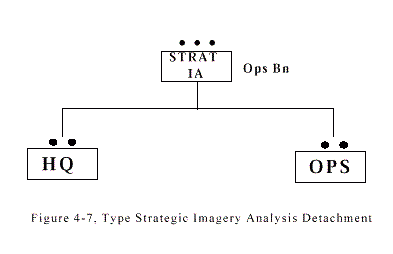
Roles and Functions
The strategic imagery analysis detachment performs exploitation of radar, infrared, E- O,
photographic, and national level imagery on a 24- hour basis. Intelligence reports are sent by either courier or electrical message to authorized theater consumers. When requested,
photographic prints of the exploited imagery are sent to division, corps, and those EAC elements requiring such products for OPSEC, planning, or contingency purposes. Specific functions of the
strategic imagery analysis company include:
Provide imagery- derived information and intelligence to the CINC J- 2, EACIC and other requesting and supported detachments.
Perform first, second, and third- phase exploitation of radar, infrared, photographic, EO,
and national level imagery.
Interface with the EACIC, J2 and J3, and Air Force liaison staffs to satisfy Army requirements.
Leverage tactical, theater and national databases.
3.5.1.3 Imagery Analysis Company
Mission
"The mission of the strategic imagery analysis detachment is to provide processing and
exploitation of theater and national level imagery and the timely dissemination of the resultant intelligence within the theater."
Organization
The imagery analysis company provides imagery processing, exploitation and dissemination in support of ASCC/ JFLCC requirements. Typical strategic imagery analysis
companies consist of a headquarters section and an operations section a Modernized Imagery Exploitation System (MIES) and Enhanced Tactical Radar Correlater (ETRAC) platoons. Figure 4-8 shows a type Strategic Imagery Analysis Detachment.

Roles and Functions
Provide imagery- derived information and intelligence to the EACIC and to other
requesting and supported units.
Conduct processing of first, second and third phase exploitation and dissemination of all
source imagery, for example; electro- optic, radar, infrared and photographic imagery.
Provide support to the corps military intelligence support element (CMISE), the ground
force commander's EACIC and the theater joint intelligence center (JIC) to ensure Army
requirements are satisfied by theater and national imagery assets.
3.5.1.4 JSTARS Detachment
Mission
"Provide aircrews to the JSTARS wing in conducting surveillance, target detection, and
tracking required to contribute to plans and operations of army service component
commanders and joint force commanders in world- wide contingency missions.
Organization
The JSTARS detachment consists of a headquarters section, a flight crew section, a training
section and a plans and exercises section. A typical JSTARS detachment is shown at Figure 4- 9.
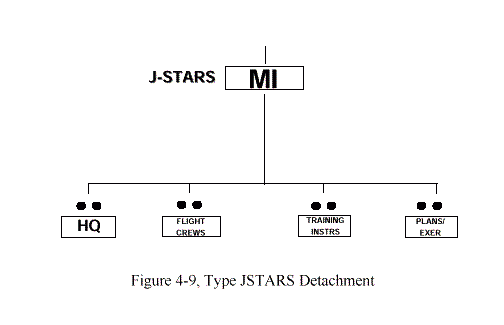
Roles and Functions
The JSTARS detachment provides a capability for near real time indications and warning
of enemy activity via a day- night all- weather radar moving- target indicator sensor. Specific
functions of the JSTARS detachment include:
Display of moving and massing target over a corps- sized sector.
Cross- cueing of other intelligence sensors.
Monitor the corps sector for battle management and targeting.
3.5.2 Signals Intelligence Battalion
This section describes the mission and structure of a generic SIGINT battalion and its major subordinate units.
Mission
"Conduct SIGINT, TCAE, and EW operations in support of ASCCJFLCC and national
requirements."
Organization
The SIGINT Battalion consist of a Headquarters, Collection Company, TCAE, EA
Company and a Regional Technical Control and Analysis Element. A typical SIGINT Battalion is shown as Figure 4-10.

Roles and Functions
The following are typical roles and functions on the SIGINT Battalion:
Collect, analyze, process, and report communications intelligence (COMINT).
Provide electronic intelligence (ELINT) processing, analysis, and reporting.
Perform direction finding (DF) and advanced identification techniques.
Conducting EA operations.
Managing the tasking and positioning of organic SIGINT mission equipment.
3.5.2.1 Collection Company
Mission
"The Collection Company conducts Electronic Support (ES) and Direction Finding (DF)operations to support Theater requirements."
Organization
The Collection Company is organized with a company headquarters and intercept/ DF
platoons. Each intercept/ DF platoon consists of one Enhanced TRACKWOLF (ET) and a C- E
and mechanical maintenance section. A typical Collection Company is shown as Figure 4- 11.
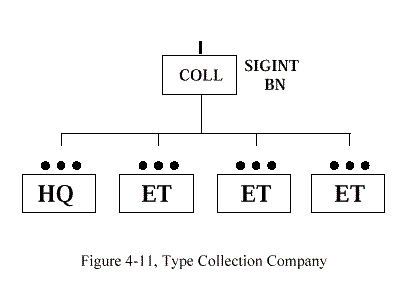
Roles and Functions
The Collection Company conducts ES operations and support to Theater with
DF/ intercept platoons using the ET system. The company is capable of deploying to over a 1000
kilometer front along an operational baseline up to 1500 kilometers with an operational ES depth
to 1500 km from this baseline. Specific functions of the Collection Company include:
Collection, processing, analysis, and reporting of COMINT derived from HF intercept
and DF operations. The company also has a variety of non- developmental items (NDI) of
equipment with multi- spectral capabilities in the UHF and VHF portions of the electromagnetic
spectrum.
Morse, non- Morse, and voice intercept support.
three HFDF platoons for target location and development.
Headquarters Section
The Headquarters section provides administrative, supply, and logistics, maintenance,
C- E maintenance, communications and C2 for ET platoons. The headquarters operations section
provides phase one analysis (immediate combat information) on collected data and reports
significant or perishable information in a time- sensitive manner.
Enhanced TRACKWOLF Platoon
The ET platoon performs collection and direction finding operations. Each platoon
consists of one ET station. The three ET platoons often operate in concert. Each ET platoon
process lines of bearing to determine geolocation and report critical information to the TCAE.
ET platoons perform limited force protection and UHF intercept operations.
3.5.2.2 Technical Control and Analysis Element
Mission
" The TCAE provides technical control and analysis of SIGINT assets assigned or attached to the FPB to support the ASCC/ JFLCC intelligence requirements.
Organization
The TCAE consists of a headquarters, communication platoon, and a TCAE platoon. The TCAE platoon is further organized into a Morse, non- Morse, voice, ELINT, CM, and reports
section. A typical TCAE is shown as Figure 4- 12.
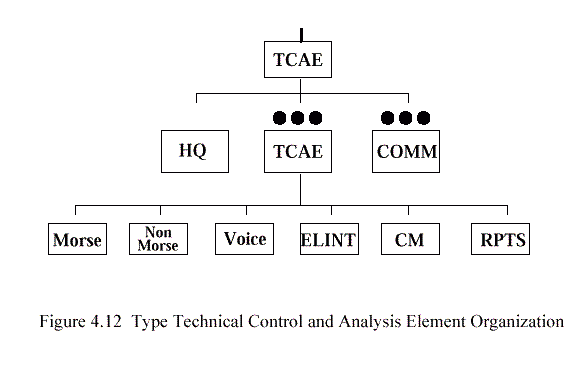
Roles and Functions
The MI company TCAE supports SIGINT tasking, conducts analysis and reporting of
collected data; disseminates technical data to customers; exchanges SIGINT with regional
SIGINT operational center (RSOC) through regional TCAEs; receives requirements from the
theater analysis and control element (ACE); interfaces with the Army TCAE and other services;
provides technical control and support to EA systems in accordance with the Army component
targeting plan; and conducts ELINT analysis, and reporting. The TCAE provides the Theater
EACIC with fused COMINT AND ELINT reporting. Specific functions of the TCAE include:
Maintain the theater SIGINT technical data base.
provides tasking and data base input in support of electronic support and resources
assigned to the FPB.
processes, analyzes and distributes COMINT information analysis and distributes
ELINT information.
provides analysis support and technical data to EAC and ECB customers.
develops signals and targets; identifies and forwards targets of interest; analyzes and
disseminates reports to customers.
conducts split- based operations.
3.5.2.3 Electronic Attack Company
Mission
"The Electronic Attack Company performs electronic support (ES) and electronic attack
(EA) missions in the high frequency (HF) spectrum in support of the ASCC/ JFLC
Commander."
Organization
The EA Company consists of a headquarters, a Army High Frequency Electronic Warfare
System (AHFEWS) Platoon and a SANDCRAB Platoon. A typical EA company is shown as
Figure 4.13.

Roles and Functions
The EA company provides the FPB an electronic attack capability using the AHFEWS and
the SANDCRAB System. Both systems conduct electronic support missions (ES) and electronic
attack (EA) missions in the HF spectrum. They can be deployed together in tandem or separate
to support multiple intelligence requirements. SANDCRAB provides the close VHF/ HF ES and
EA while AHFEWS provides the long- range multiple target HF ES and EA support. Specific
functions of the EA company include:
Collection, transcription, analysis and management of radio frequency signals.
Detect and analyze primary modulation and signal parameters
Directs simultaneous EA missions against multiple targets.
In- depth signal analysis and signal verification.
3.5.3 Aerial Reconnaissance Battalion (ARB)
This section describes the mission and structure of a generic aerial reconnaissance
battalion and its major subordinate units.
Mission
"The Aerial Reconnaissance Battalion conducts airborne IEW operations to support the ASCC/ JFLC Commander's requirements."
Organization
The ARB consists of a headquarters company, an aerial exploitation company
and an airborne reconnaissance company - Low. A typical ARB is shown as figure 4- 14.
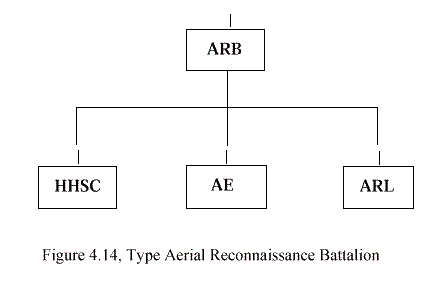
Roles and Functions
Specific roles and functions of the ARB include:
Deploy aerial collection platforms and supporting assets to support IEW contingency
operations
Integrate RC aerial collection/ DF systems into battalion operations.
Incorporate new airborne collection equipment and develop employment doctrine for
unit aerial reconnaissance operations.
3.5.3.1 Airborne Reconnaissance Low
Mission
" The Airborne Reconnaissance Low Company provides near real time COMINT and IMINT collection and direction- finding in support of ASCC/ JFLC Commander's
requirements."
Organization
The ARL consists of a headquarters, an operations platoon, flight section, aerial
surveillance, and an electronic warfare section. A typical ARL Company is shown as Figure 4- 15.

Roles and Functions
The ARL- M provides near real time COMINT and IMINT collection support and DF
support. It operates a system consisting of an ES subsystem, a forward looking infrared (FLIR)
subsystem, infrared line scanner subsystem, and a daylight imaging system mounted in nine de
Havilland DASH-aircraft. Specific functions of the ARL include:
.
Perform intelligence collection and reporting through an integration of aerial electro-
optic sensors, radar, and COMINT payload suites which are used to observe and record items of
intelligence interest.
42
Sustain a multi- discipline mission sortie rate of sorties per aircraft per month.
Deploy tailored packages of one to nine aircraft including support personnel and
equipment in support of regional conflicts.
Maintain a capability to fly dual ship missions and perform simultaneous DF through
air- to- air datalink.
3.5.3.2 Aerial Exploitation Company
(Guardrail/ Common Sensor)
Mission
"The Aerial Exploitation Company provides aerial SIGINT collection and direction finding in support of the ASCC/ JFLC Commander's intelligence requirements."
Organization
The AE company consists of a headquarters, collection and analysis platoon, flight
operations platoon, and a combat service support platoon. A typical AE company is shown as
Figure 4- 16.
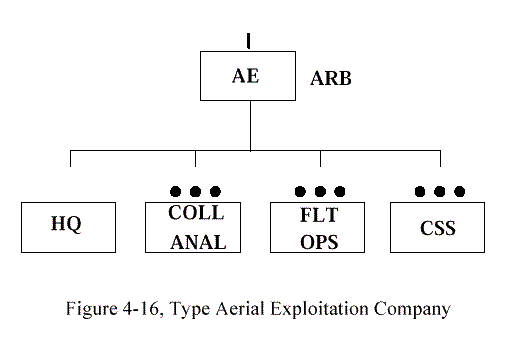
Roles and
Functions
Specific roles and functions of the aerial exploitation company include:
Provide airborne SIGINT, collection, and DF of HF, VHF, and UHF radio
communications.
Analyze, transcribe, and report COMINT to the TCAE of the supported unit.
3.5.4 Technical Intelligence Battalion
BATTLEFIELD TECHNICAL INTELLIGENCE
This section describes the mission and structure of the Technical Intelligence Battalion and its major subordinate units.
Mission
"The TECHINT Battalion provides intelligence derived from the exploitation of weapons,equipment and other material found, captured or acquired in the Theater of operations."
Organization
The TECHINT Battalion consists of a headquarters company, a technical exploitation
company, and a technical collection company. There is only one TECHINT battalion currently in the active component. TECHINT companies from the resource component will mobilize in times
of crisis to augment FPBs and other units as required. A typical TECHINT battalion is shown in figure 4- 17.

Roles and Functions
TECHINT units perform both a collection and exploitation role. Collection and
exploitation teams are formed to provide technical and analytical support to divisions and corps as necessary, or the TECHINT company may form the nucleus of the captured material exploitation
center (CMEC).
The CMEC evaluates captured enemy material to determine its level of TECHINT interest and importance. CMECs then conduct rapid, initial scientific and technological analysis of the
material. Any immediate countermeasures, information or intelligence developed is quickly distributed to the appropriate combat, combat support, or combat service support units for
immediate use. CMECs are responsible for ensuring the rapid evacuation of the material from
theater to specialized agencies in CONUS for a more in- depth, detailed exploitation. CMECs are formed during wartime or contingency operations only. Specific functions of TECHINT include:
Analyses and exploitation of foreign and technical equipment, weapon systems, and
other war materiel.
Assessments of the capabilities and limitations of enemy combat material.
Reports alerting the command to the tactical threat posed by technical advances in new or recently discovered foreign and enemy materiel.
Recommendations for countermeasures for any enemy technical advantage.
Providing foreign and enemy equipment for troop familiarization and training.
On- site supervision of evacuations of items of extreme interest to TECHINT analysts.
Task- organized battlefield TECHINT teams to support a subordinate command's
TECHINT effort.
3.5.5 Collection and Exploitation Battalion
This section describes the mission and structure of a generic collection and exploitation
battalion (C& E) and its major subordinate units. 26
Mission
"The collection and exploitation battalion collects intelligence information through the acquisition, training, briefing and debriefing of HUMINT assets in support of US Army
requirements at EAC and provides CI support within the theater of operations, conducts interrogations of prisoners of war and other personnel of intelligence interest; translates
and exploits selected foreign documents/ media; and exploits foreign materiel of intelligence interest."
Organization
The MI battalion (C& E), shown at Figure 4- 18, is organized into a headquarters
company, an MI company (CI), an MI company (interrogation and exploitation), and an MI company (collection and exploitation). Headquarters company provides C2, administrative
services, and logistic support for units of the battalion. It also provides operational coordination between the three MI companies and the EACIC. A critical function of the C& E battalion is to
form CI/ HUMINT teams for modular, scaleable employment in support of intelligence requirements. These teams can be formed either at the battalion level integrating elements from
the CI and I& E companies, or at the company level, from elements of the CI and I& E platoons of the C& E company.

Roles and Functions
The Collection and Exploitation Battalion provides interrogation and CI support for the Army
Service Component Commander. Specific functions of the C& E Battalion include:
Provide CI support, including analysis of the multidiscipline threat and CI technical support with polygraph and technical surveillance countermeasures teams.
Establishment of a joint or combined interrogation facility and conduct interrogations of
EPWs. Conduct debriefings of high level political and military personnel, civilian internees,refugees, displaced persons, and other non- US personnel.
Translate and exploit documents acquired, found, or captured in the theater AO.
Debrief US and Allied personnel who< have escaped after being captured or who have
evaded capture.
Conduct Counterintelligence Force Protection Source Operations (CFSO).
3.5.5.1 MILITARY INTELLIGENCE COMPANY (CI)
Mission
"The mission of the MI Company (CI) is to conduct CI operations and
multidiscipline counterintelligence (MDCI) threat analysis in support of ASCC requirements."
Organization
The MI company (CI), shown at Figure 4- 19, consists of a company headquarters section,operations element, and CI teams element.
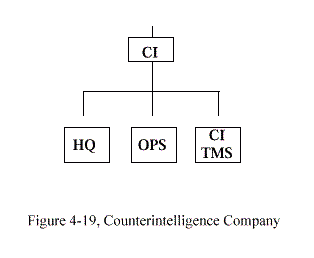
Roles and Functions
Provides MDCI support (counter- human intelligence [C- HUMINT]) to the EACIC and commands within the COMMZ.
Performs liaison with US, joint, and combined commands and allied and host nation CI
counterparts.
Conducts CI investigations.
Reinforces ECB CI activities.
Conducts wartime offensive CI operations within the FPB AO.
Special operations teams conduct counterespionage, countersubversion, and countersabotage operations and investigations (see FM 34-and 34- 60). These teams also
conduct Counterintelligence Force Protection Source Operations (CFSO). CI jurisdiction includes-
- Known or suspected acts of espionage.
- CI aspects of known or suspected foreign- directed sabotage.
- Limited investigations regarding contact with elements of threat governments.
- Subversive activity by Army personnel.
- Known or suspected acts of treason or sedition by Army personnel.
- CI aspects of terrorism and assassination.
- Army defections, detentions, and unexplained absences of Army personnel.
- Impersonations of MI personnel. (Specific investigations and legal responsibilities are
in AR 381-and AR 381- 20.)
3.5.5.3 MI COMPANY (INTERROGATION AND EXPLOITATION)
Mission
"The mission of the MI Company (Interrogation and Exploitation) is to conduct interrogations of enemy prisoners of war (EPWs) and debriefings of other personnel of
intelligence interest and to exploit captured enemy documents (CEDs) in Army, joint, or combined interrogation centers."
Organization
The MI Company (Interrogation and Exploitation) consists of a company headquarters,
operations section, communications section, and interrogation and exploitation (I& E) platoon.
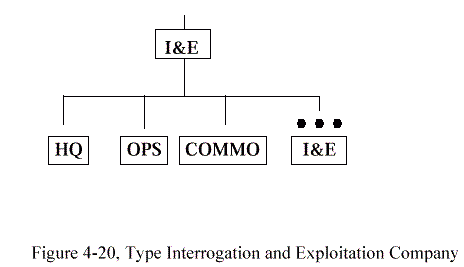
Roles and Functions
Establishment of a joint or combined interrogation facility and conduct interrogations of
EPWs. Conduct debriefings of high level political and military personnel, civilian internees,refugees, displaced persons, and other non- US personnel.
Translate and exploit documents acquired, found, or captured in the theater AO.
Debrief US and Allied personnel having escaped after being captured or having evaded
capture.
3.5.5.4 MI COMPANY (COLLECTION AND EXPLOITATION)
The collection and exploitation company combines the functions of the CI and I& E
companies into one company- sized element. This company provides a tailored, scaleable capabilities package of CI and interrogation support that is permanently task- organized for
situations requiring CI/ HUMINT support but which do not allow or require the full involvement of a battalion- sized unit. The C& E company can form CI/ HUMINT teams from the CI and I& E
platoons to conduct integrated CI/ HUMINT operations.
Mission
"The mission of the MI Company (Collection and Exploitation) is to provide CI support within the theater of operations, conduct interrogations of EPWs and debriefings
of other personnel of intelligence interest; translate and exploit selected foreign documents/ media; and exploits foreign materiel of intelligence interest."
Organization
The MI Company (Collection and Exploitation) consists of a company headquarters, CI
operations section, interrogation operations section, and counterintelligence and I& E platoons.
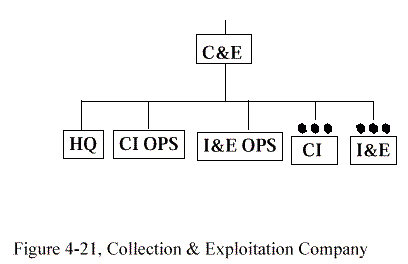
Roles and Functions
Provides C- HUMINT support to the EACIC and commands within the COMMZ. 7
Performs liaison with US, joint, and combined commands and Allied and host nation CI counterparts.
Conducts CI investigations.
Reinforces ECB CI activities.
Conducts wartime offensive CI operations within the FPB AO.
Establishment of a joint or combined interrogation facility and conducts interrogations
of EPWs. Conduct debriefings of high level political and military personnel, civilian internees,refugees, displaced persons, and other non- US personnel.
Translate and exploit documents acquired, found, or captured in the theater AO.
Debrief US and allied personnel having escaped after being captured or having evaded
capture.
Special operations teams conduct counterespionage, countersubversion, and countersabotage operations and investigations (see FM 34-and 34- 60). These teams also
conduct CFSO. CI jurisdiction includes--
- Known or suspected acts of espionage.
- CI aspects of known or suspected foreign- directed sabotage.
- Limited investigations regarding contact with elements of threat governments.
- Subversive activity by Army personnel.
- Known or suspected acts of treason or sedition by Army personnel.
- CI aspects of terrorism and assassination.
- Army defections, detentions, and unexplained absences of Army personnel.
- Impersonations of MI personnel.
(Specific investigations and legal responsibilities are in AR 381-and AR 381- 20.)
3.6 Reserve Component Support
This section describes reserve component support to FPB.
Mission
"Provide multi- discipline intelligence, force protection, EW and information warfare
support to FPBs."
Organization
The reserve components (RC) in support of Corps and EAC include the entire USAR MI
unit force, the ARNG's Linguist Brigade and individual mobilization augmentees. Each RC MI
group will be aligned with a force protection area of responsibility in support of a single MRC.
Figure 4-22 outlines these RC MI structures.

Roles and Functions
The reserve component supports the FPB through modular deployed teams designed to
augment AC capabilities, or through split- based operations from sanctuary. USAR and ARNG MI
augmentation is provided by cellular/ modular teams. Each team is accessible, on mobilization, via
a derivative unit identification code (UIC) allowing commands to activate only the particular
teams or sections in support of mission requirements. RC MI companies and battalions
supporting EAC do not replicate AC formations. Instead, they consist of several functionally
oriented, modular teams. These teams augment the existing AC structure. Team elements, not
aligned to EAC, may be cross- leveled as needed.
The RC's team and individual augmentation is governed by WARTRACE relationships. The WARTRACE program formally aligns Army units to gaining commands. This deliberate
alignment of RC to AC drives planning, METL development, training and contributory intelligence support. Upon mobilization, the modular RC MI teams plug into the AC and
becomes organic elements of the AC MI unit.
3.7 Theater MI components
This section describes the mission, organization and roles and functions of Theater MI components. These are ad hoc, provisional organizations and represent the forward- deployed
capabilities of the FPBs residing in- theater and provide direct intelligence support to the Army Service Commander.
Mission
"Theater MI components conduct multi- discipline intelligence, force protection,
EW, and information warfare operations in direct support of their specific Theater Army
Component Commanders. Theater MI components support other deploying forces in
providing timely critical intelligence support to the Theater CINC, Army Service
Component or Joint Task Force as necessary during peace time, war, and support and
stabilization operations."
Organization
The Theater MI component is an ad hoc organization tailored to meet specific theater requirements. They range in size from a company to a multi- battalion Group and are a capability-
based force which embody the tenets of modularity and minimal command and control infrastructure. If additional assets or capabilities are required in- theater, the MI component
possesses a "reach- back" capability to leverage CONUS- based FPB resources in support of the theater Army Service Component Commander.
Roles and Functions
The Theater MI components perform multi- discipline intelligence, force protection, EW
and IO operations to support the ACC/ JFLC commander's requirements. Specific functions
include:
Provide intelligence and CI in support of information warfare/ information operations
(IW/ IO). The Army will fully develop its ability to provide intelligence in support of the three
subcomponents of IO: C2 Attack, C2 Exploit, and C2 Protect.
Conduct intelligence collection and production. All intelligence disciplines and
associated sensors are included.
Conduct intelligence operations in support of force protection. In support of force
protection, the MI component leverages its CI resources to support the ACC/ JFLCC J- 2.
The objective of intelligence in direct support of the warfighter is to collect, analyze,
produce, and disseminate combat information and intelligence to assist the direction and
synchronization of maneuver and support forces. The intelligence functions include the capability
to conduct Indications and Warnings (I& W), Intelligence Preparation of the Battlespace (IPB),
situation development, targeting, force protection, and battle damage assessment (BDA).


























